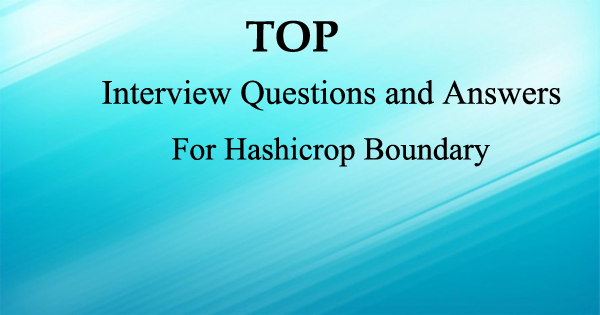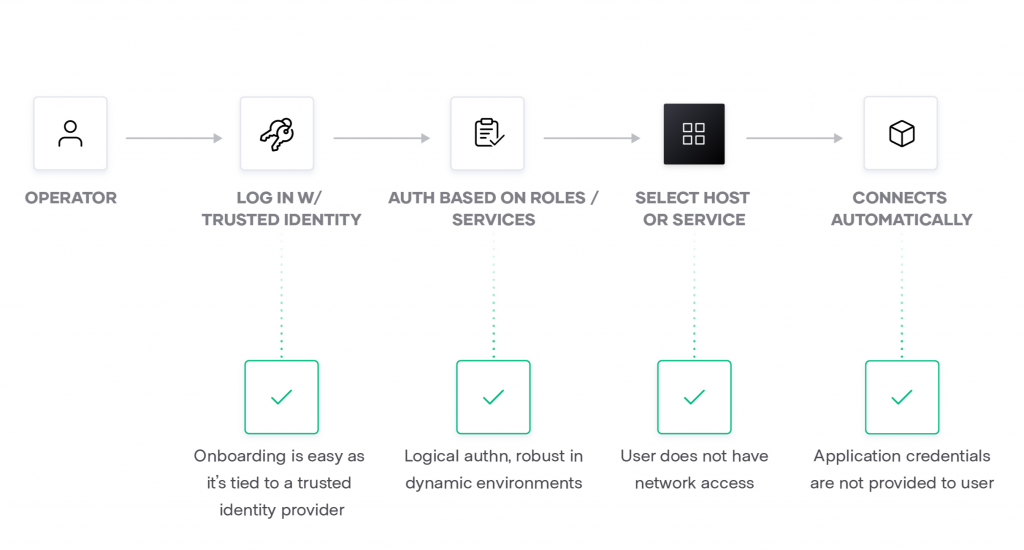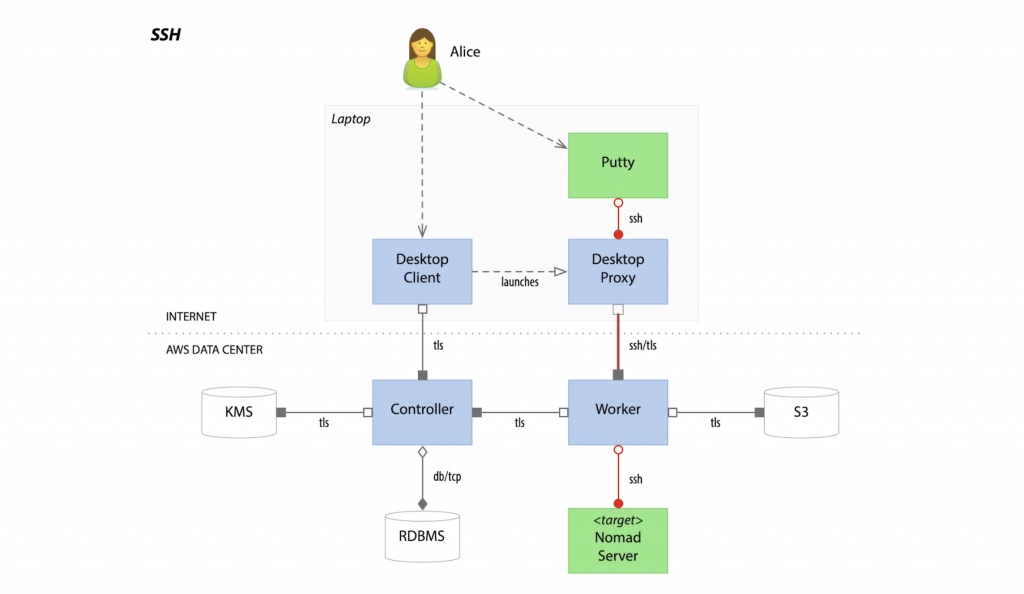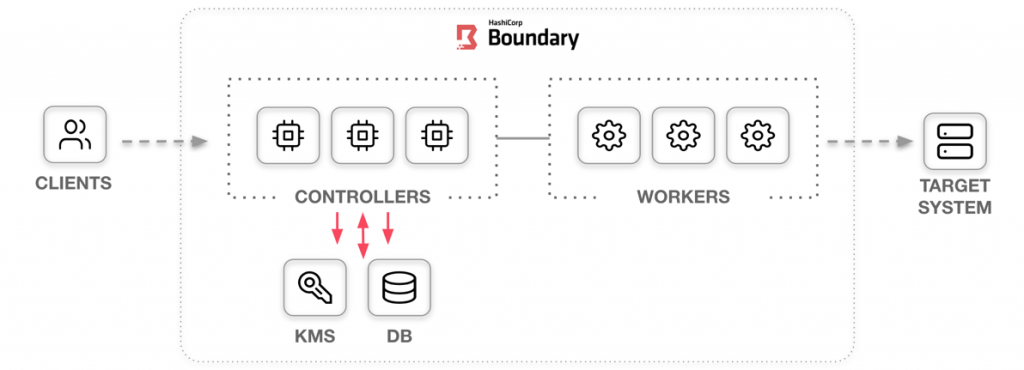
The HashiCorp Boundary is a safe remote access solution that offers an easy way to allow access to applications and critical systems with fine-grained authorizations based on trusted identities.

Through clouds, local data centers, low-trust networks, the Boundary provides an easier way to protect and safeguard access to application and critical systems by trusted identities without exposing the fundamental network.
Interview Questions and Answers:-
Q1. What is Hashicrop Boundary?

The HashiCorp Boundary is a very safe remote access solution that gives you an easy way to allow access to applications and critical systems with fine-grained authorizations based on trusted identities.
Q2. What are the benefits of Boundary?

It gives you to manage access to AWS services and resources securely. By Using (IAM), you can create and manage AWS users and groups, and use permissions to allow and deny their access to AWS resources. The Teleport makes it easy for users to securely access infrastructure and meet the toughest compliance requirements.
Q3. What is the use of Boundary?

The hashicrop Boundary provides a secure way to access hosts and critical systems without having to manage credentials or expose your network, and is fully open source.
Q4. What is an ORM tool?
It is basically a technique that maps the object that is stored in the database. An ORM tool helps in simplifying data creation, manipulation, and access. It internally uses the Java API to interact with the databases.
Q5. Why use Hibernate Framework?
- Hibernate overcomes the shortcomings of other technologies like JDBC.
- It overcomes the database dependency faced in the JDBC.
- Changing of the databases cost a lot working on JDBC, hibernate overcomes this problem with flying colors.
- Code portability is not an option while working on JDBC. This is easily handled by Hibernate.
- Hibernate strengthens the object level relationship.
- It overcomes the exception-handling part which is mandatory while working on JDBC.
- It reduces the length of code with increased readability by overcoming the boilerplate problem.
Q6. What are the different functionalities supported by Hibernate?
- Hibernate is an ORM tool.
- Hibernate uses Hibernate Query Language(HQL) which makes it database-independent.
- It supports auto DDL operations.
- This Java framework also has an Auto Primary Key Generation support.
- Supports cache memory.
- Exception handling is not mandatory in the case of Hibernate.
Q7. What are the technologies that are supported by Hibernate?
Hibernate supports a variety of technologies, like:
- XDoclet Spring
- Maven
- Eclipse Plug-ins
- J2EE
Q8. What is HQL?
HQL is the acronym of Hibernate Query Language. It is an Object-Oriented Query Language and is independent of the database.
Q9. How to achieve mapping in Hibernate?
Association mappings are one of the key features of Hibernate. It supports the same associations as the relational database model. They are:
One-to-One associations
Many-to-One associations
Many-to-Many associations
You can map each of them as a uni- or bidirectional association.
Q10. Name some of the important interfaces of the Hibernate framework?
Hibernate interfaces are:
SessionFactory (org.hibernate.SessionFactory)
Session (org.hibernate.Session)
Transaction (org.hibernate.Transaction)
Q11. What is One-to-One association in Hibernate?
In this type of mapping, you only need to model the system for the entity for which you want to navigate the relationship in your query or domain model. You need an entity attribute that represents the association, so annotate it with an @OneToOne annotation.
Q12. What is the One-to-Many association in Boundary?
In this type of association, one object can be associated with multiple/different objects. Talking about the mapping, the One-to-Many mapping is implemented using a collection that does not have any redundant elements. This One-to-Many element of the set indicates the relation of one object to multiple objects.
Q13. What is Many-to-Many association in Boundary?
Many-to-Many mapping requires an entity attribute and a @ManyToMany annotation. It can either be unidirectional and bidirectional. In Unidirectional, the attributes model the association and you can use it to navigate it in your domain model or JPQL queries. The annotation tells Hibernate to map a Many-to-Many association. bidirectional relationship, mapping allows you to navigate the association in both directions.
Q14. How to integrate boundary and Spring?
Boundary is also one of the most commonly used Java frameworks in the market today. Spring is a JavaEE Framework and Hibernate is the most popular ORM framework. This is why Spring Hibernate combination is used in a lot of enterprise applications.
The following are the steps you should follow to integrate Spring and Hibernate.
Add Hibernate-entity manager, Hibernate-core, and Spring-ORM dependencies.
Create Model classes and corresponding DAO implementations for database operations. The DAO classes will use SessionFactory that will be injected by the Spring Bean configuration.
Note that you don’t need to use Hibernate Transaction Management, as you can leave it to the Spring declarative transaction management using @Transactional annotation.
Q15. What do you mean by Boundary Configuration File?
Boundary Configuration File mainly contains database-specific configurations and are used to initialize SessionFactory. Some important parts of the Hibernate Configuration File are Dialect information, so that hibernate knows the database type and mapping file or class details.
Q16. Mention some important annotations used for Boundary mapping?
Boundary supports JPA annotations. Some of the major annotations are:
- javax.persistence.Entity: This is used with model classes to specify they are entity beans.
- javax.persistence.Table: It is used with entity beans to define the corresponding table name in the database.
- javax.persistence.Access: Used to define the access type, field or property. The default value is field and if you want Hibernate to use the getter/setter methods then you need to set it to a property.
- javax.persistence.Id: Defines the primary key in the entity bean.
- javax.persistence.EmbeddedId: It defines a composite primary key in the entity bean.
- javax.persistence.Column: Helps in defining the column name in the database table.
- javax.persistence.GeneratedValue: It defines the strategy to be used for the generation of the primary key. It is also used in conjunction with javax.persistence.GenerationType enum.
Q17. What is Session in Boundary and how to get it?
Boundary Session is the interface between the Java application layer and Hibernate. It is used to get a physical connection with the database. The Session object created is lightweight and designed to be instantiated each time an interaction is needed with the database. This Session provides methods to create, read, update, and delete operations for a constant object. To get the Session, you can execute HQL queries, SQL native queries using the Session object.
Q18. What is Hibernate SessionFactory?
SessionFactory is the factory class that is used to get the Session objects. The SessionFactory is a heavyweight object so usually, it is created during application startup and kept for later use. If you are using multiple databases then you would have to create multiple SessionFactory is a thread-safe object which is used by all the threads of an application. I SessionFactory objects.
Q19. What is the difference between openSession and getCurrentSession?
This getCurrentSession() method returns the session bound to the context and for this to work, you need to configure it in the Hibernate configuration file. Since this session object belongs to the context of Hibernate, it is okay if you don’t close it. Once the SessionFactory is closed, this session object gets closed.
openSession() method helps in opening a new session. You should close this session object once you are done with all the database operations. And also, you should open a new session for each request in a multi-threaded environment.
Q20. What do you mean by Boundary configuration file?
- The following steps help in configuringHibernatefile:
- First, identify the POJOs (Plain Old Java Objects) that have a database representation.
- Identify which properties of POJOs need to be continued.
- Annotate each of the POJOs in order to map the Java objects to columns in a database table.
- Create a database schema using the schema export tool which uses an existing database, or you can create your own database schema.
- Add Hibernate Java libraries to the application’s classpath.
- Create a Hibernate XML configuration file that points to the database and the mapped classes.
- In the Java application, you can create a Hibernate Configuration object that refers to your XML configuration file.
- Also, build a Hibernate SessionFactory object from the Configuration object.
- Retrieve the Hibernate Session objects from the SessionFactoryand write down the data access logic for your application (create, retrieve, update, and delete).
Q21. What are the key components of a Boundary configuration object?
The configuration provides 2 key components, namely:
Database Connection: This is handled by one or more configuration files.
Class Mapping setup: It helps in creating the connection between Java classes and database tables.
Q22. Discuss the Collections in Boundary
Boundary provides the facility to persist the Collections. A Collection basically can be a List, Set, Map, Collection, Sorted Set, Sorted Map. java.util.List, java.util.Set, java.util.Collection, etc, are some of the real interface types to declared the persistent collection-value fields. Hibernate injects persistent Collections based on the type of interface. The collection instances generally behave like the types of value behavior.
Q23. What are the collection types in boundary?
There are five collection types in hibernate used for one-to-many relationship mappings.
Q24. What is a Boundary Template class?
When you integrate Spring and Hibernate, Spring ORM provides two helper classes — HibernateDaoSupport and HibernateTemplate. The main reason to use them was to get two things, the Session from Hibernate and Spring Transaction Management. However, from Hibernate 3.0.1, you can use the SessionFactory getCurrentSession() method to get the current session. The major advantage of using this Template class is the exception translation but that can be achieved easily by using @Repository annotation with service classes.
Q25. What are the benefits of using Hibernate template?
The following are the benefits of using this Hibernate template class:
- Automated Session closing ability.
- The interaction with the Hibernate Session is simplified.
- Exception handling is automated.
Q26. Which are the design patterns that are used in the Hibernate framework?
There are a few design patterns used in Hibernate Framework, namely:
Domain Model Pattern: An object model of the domain that incorporates both behaviors as well as data.
Data Mapper: A layer of the map that moves data between objects and a database while keeping it independent of each other and the map itself.
Proxy Pattern: It is used for lazy loading.
Factory Pattern: Used in SessionFactory.
Q27. Define Hibernate Validator Framework
Data validation is considered as an integral part of any application. Also, data validation is used in the presentation layer with the use of Javascript and the server-side code before processing. It occurs before persisting it in order to make sure it follows the correct format. Validation is a cross-cutting task, so we should try to keep it apart from the business logic. This Hibernate Validator provides the reference implementation of bean validation specs.
Q28. What is Dirty Checking in Boundary?
Boundary incorporates Dirty Checking feature that permits developers and users to avoid time-consuming write actions. This Dirty Checking feature changes or updates fields that need to be changed or updated, while keeping the remaining fields untouched and unchanged.
Q29. How can you share your views on mapping description files?
Mapping description files are used by the Hibernate to configure functions.
These files have the *.hbm extension, which facilitates the mapping between database tables and Java class.
Whether to use mapping description files or not this entirely depends on business entities.
Q30. What is meant by Light Object Mapping?
This means that the syntax is hidden from the business logic using specific design patterns. This is one of the valuable levels of ORM quality and this Light Object Mapping approach can be successful in case of applications where there are very fewer entities, or for applications having data models that are metadata-driven.
Q31. What is meant by Hibernate tuning?
- Optimizing the performance of Hibernate applications is known as Hibernate tuning.
- The performance tuning strategies for Hibernate are:
- SQL Optimization
- Session Management
- Data Caching
Q32. What is Transaction Management in boundary? How does it work?
Transaction Management is a property that is present in the Spring framework. Now, what role does it play in Hibernate?
Transaction Management is a process of managing a set of commands or statements. In hibernate, Transaction Management is done by transaction interface. It maintains abstraction from the transaction implementation (JTA, JDBC). A transaction is associated with Session and is instantiated by calling session.beginTransaction().
Q33. How do you integrate Hibernate with Struts2 or Servlet web applications?
You can integrate any Struts application with Hibernate. There are no extra efforts required.
Register a custom ServletContextListener.
In the ServletContextListener class, first, initialize the Hibernate Session, store it in the servlet context.
Action class helps in getting the Hibernate Session from the servlet context, and perform other Hibernate task as normal.
Q34. What are the different states of a persistent entity?
It may exist in one of the following 3 states:
- Transient: This is not associated with the Session and has no representation in the database.
- Persistent: You can make a transient instance persistent by associating it with a Session.
- Detached: If you close the Hibernate Session, the persistent instance will become a detached instance.
Q35. How can the primary key be created by using Hibernate?
A Primary key is a special relational database table column designated to uniquely identify all table records. It is specified in the configuration file hbm.xml. The generator can also be used to specify how a Primary key can be created in the database.
<id name=”ClassID” type=”string” > <column name= “columnID” length=”10″ > <generator/> </id>
Q36. Explain about Hibernate Proxy and how it helps in Lazy loading?
Hibernate uses a proxy object in order to support Lazy loading.
When you try loading data from tables, Hibernate doesn’t load all the mapped objects.
After you reference a child object through getter methods, if the linked entity is not present in the session cache, then the proxy code will be entered into the database and load the linked object.
It uses Java to assist to effectively and dynamically generate sub-classed implementations of your entity objects.
Q37. How can we see Hibernate generated SQL on the console?
In order to view the SQL on a console, you need to add the following in the Hibernate configuration file to enable viewing SQL on the console for debugging purposes:
<property name=”show_sql”>true</property>
Q38. What is Query Cache in Hibernate?
Hibernate implements a separate cache region for queries resultset that integrates with the Hibernate second-level cache. This is also an optional feature and requires a few more steps in code.
Note: This is only useful for queries that are run frequently with the same parameters.
Q39. What is the benefit of Native SQL query support in Hibernate?
Hibernate provides an option to execute Native SQL queries through the use of the object. For normal scenarios, it is however not the recommended approach because you might lose other benefits like Association and Hibernate first-level caching.
Native SQL Query comes handy when you want to execute database-specific queries that are not supported by Hibernate API such query hints or the Connect keyword in Oracle Database.
Q40. What is Named SQL Query?
Hibernate provides another important feature called Named Query using which you can define at a central location and use them anywhere in the code.
You can create named queries for both HQL as well as for Native SQL. These Named Queries can be defined in Hibernate mapping files with the help of JPA annotations @NamedQuery and @NamedNativeQuery.
Q41. When do you use merge() and update() in Hibernate?
This is one of the tricky Hibernate Interview Questions asked.
- update(): If you are sure that the Hibernate Session does not contain an already persistent instance with the same id.
- merge(): Helps in merging your modifications at any time without considering the state of the Session.
Q42. Difference between get() vs load() method in Hibernate?
This is one of the most frequently asked Hibernate Interview Questions. The key difference between the get() and load() method is:
load(): It will throw an exception if an object with an ID passed to them is not found.
get(): Will return null.
load(): It can return proxy without hitting the database unless required.
get(): It always goes to the database.
So sometimes using load() can be faster than the get() method.
Q43. Difference between the first and second level cache in Hibernate?
The first-level cache is maintained at Session level while the second level cache is maintained at a SessionFactory level and is shared by all sessions.
Q44. Difference between Session and SessionFactory in Hibernate?
This is yet another popular Hibernate Interview Question asked.
A Session is a single-threaded, short-lived object. It provides the first-level cache.
SessionFactory is immutable and shared by all Sessions. It also lives until the Hibernate is running. It also provides the second-level cache.
Q45. Difference between save() and saveOrUpdate() method of Hibernate?
Even though save() and saveOrUpdate() method is used to store an object into Database, the key difference between them is that save() can only Insert records but saveOrUpdate() can either Insert or Update records.
Q46. Difference between sorted and ordered collection in Hibernate?
sorted collection sort the data in JVM’s heap memory using Java’s collection framework sorting methods. The ordered collection is sorted using order by clause in the database itself.
Note: A sorted collection is more suited for small datasets but for a large dataset, it’s better to use ordered collection to avoid
Q47. Difference between the transient, persistent, and detached state in Hibernate?
Transient state: New objects are created in the Java program but are not associated with any Hibernate Session.
Persistent state: An object which is associated with a Hibernate session is called a Persistent object. While an object which was earlier associated with the Hibernate session but currently it’s not associate is known as a detached object. You can call save() or persist() method to store those object into the database and bring them into the Persistent state.
Detached state: You can re-attach a detached object to Hibernate sessions by calling either update() or saveOrUpdate() method.
Q48. Difference between managed associations and Hibernate associations?
Managed associations: Relate to container management persistence and are bi-directional.
Hibernate Associations: These associations are unidirectional.
Q49. What are the best practices that Hibernate recommends for persistent classes?
- All Java classes that will be persisted need a default constructor.
- All classes should contain an ID in order to allow easy identification of your objects within Hibernate and the database. This property maps to the primary key column of a database table.
- All attributes that will be persisted should be declared private and have getXXXand setXXXmethods defined in the JavaBean style.
- A central feature of Hibernate, proxies, depends upon the persistent class being either non-final or the implementation of an interface that declares all public methods.
- All classes that do not extend or implement some specialized classes and interfaces required by the EJB framework.
Q50. What are the best practices to follow with Hibernate framework?
- Always check the primary key field access, if it’s generated at the database layer then you should not have a setter for this.
- By default hibernate set the field values directly, without using setters. So if you want Hibernate to use setters, then make sure proper access is defined as @Access(value=AccessType.PROPERTY).
- If the access type is property, make sure annotations are used with getter methods and not setter methods. Avoid mixing of using annotations on both filed and getter methods.
- Use native SQL query only when it can’t be done using HQL, such as using the database-specific feature.
- If you have to sort the collection, use an ordered list rather than sorting it using Collection API.
- Use named queries wisely, keep it at a single place for easy debugging. Use them for commonly used queries only. For entity-specific query, you can keep them in the entity bean itself.
- For web applications, always try to use JNDI DataSource rather than configuring to create a connection in hibernate.
- Avoid Many-to-Many relationships, it can be easily implemented using bidirectional One-to-Many and Many-to-One relationships.
Here is the video tutorial:-
I’m a DevOps/SRE/DevSecOps/Cloud Expert passionate about sharing knowledge and experiences. I am working at Cotocus. I blog tech insights at DevOps School, travel stories at Holiday Landmark, stock market tips at Stocks Mantra, health and fitness guidance at My Medic Plus, product reviews at I reviewed , and SEO strategies at Wizbrand.
Do you want to learn Quantum Computing?
Please find my social handles as below;
Rajesh Kumar Personal Website
Rajesh Kumar at YOUTUBE
Rajesh Kumar at INSTAGRAM
Rajesh Kumar at X
Rajesh Kumar at FACEBOOK
Rajesh Kumar at LINKEDIN
Rajesh Kumar at PINTEREST
Rajesh Kumar at QUORA
Rajesh Kumar at WIZBRAND

